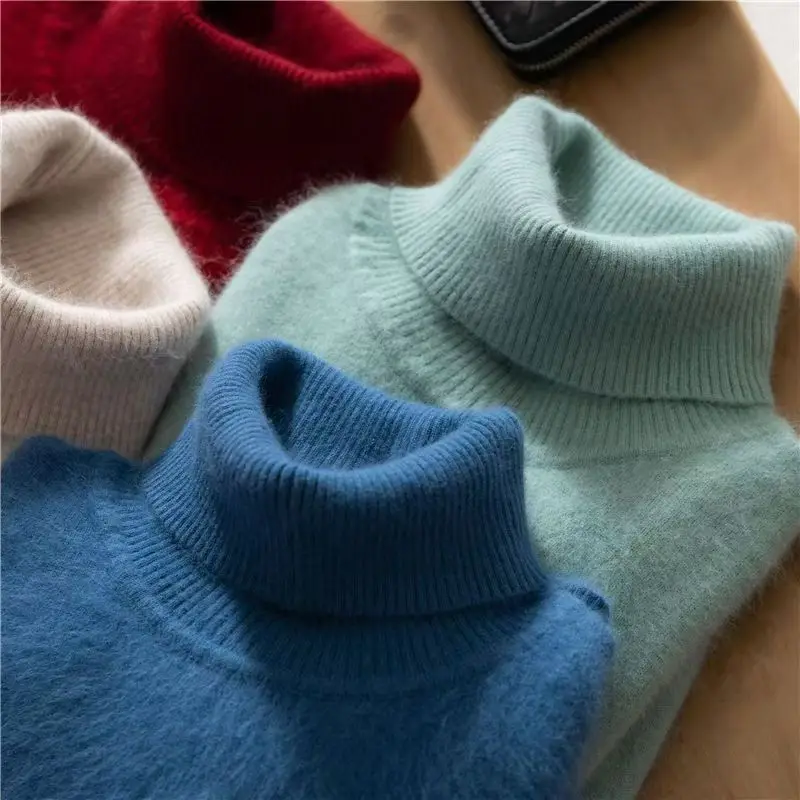When most people think of cashmere, they immediately picture cozy winter sweaters and scarves. But is this luxurious fabric really limited to just one season? Understanding when and how to wear cashmere throughout the year can help you make the most of this premium material and extend your wardrobe’s versatility.
Understanding Cashmere’s Exceptional Properties
Cashmere is a premium natural fiber harvested from the soft undercoat of cashmere goats. What makes this material truly remarkable is its unique fiber structure – cashmere fibers are incredibly fine (under 16 microns in diameter for premium grades) and feature a hollow core that creates exceptional insulation properties.
This distinctive structure gives cashmere several remarkable qualities:
- Outstanding warmth-to-weight ratio: Cashmere provides up to three times more insulation than regular wool while remaining significantly lighter
- Natural temperature regulation: The hollow fibers trap air, creating thermal insulation that adapts to your body
- Superior breathability: Unlike synthetic materials, cashmere allows air circulation while maintaining warmth
- Moisture-wicking abilities: The fibers can absorb moisture without feeling wet, keeping you comfortable
- Unmatched softness: Premium cashmere feels incredibly gentle against the skin, unlike some scratchy wools
These properties don’t just make cashmere ideal for winter – they allow this versatile fiber to adapt across cashmere transitional weather conditions throughout the year. The natural evolution of cashmere itself explains this adaptability – mountain goats developed these fibers to protect them from extreme cold while allowing comfort during seasonal temperature variations.
Cashmere for Cold Weather: Winter’s Perfect Companion
Cold weather is where cashmere truly shines. In temperatures below 32°F (0°C), cashmere’s exceptional insulating properties create a warm microclimate around your body while remaining remarkably lightweight.
The science behind this exceptional performance lies in cashmere’s fiber structure. The hollow core of each fiber traps body heat while the natural crimp of the fibers creates tiny air pockets that provide additional insulation. This makes cashmere particularly effective in:
- Maintaining consistent warmth even in fluctuating temperatures
- Providing insulation without the bulkiness of synthetic materials
- Offering comfort during extended outdoor exposure
For optimal winter warmth, look for heavyweight cashmere options:
– 4-ply cashmere sweaters and mens cashmere turtlenecks provide maximum insulation
– Chunky knit styles trap additional air for enhanced warmth
– Tightly woven cashmere accessories like scarves, hats, and gloves protect extremities
When temperatures drop further, cashmere excels as a layering piece. A thin cashmere base layer under a heavier cashmere sweater creates exceptional warmth while maintaining freedom of movement – making it perfect for cold weather cashmere outfits that combine style and functionality.
Cashmere for Transitional Weather: Fall and Spring Versatility
As temperatures fluctuate between 50-68°F (10-20°C) during spring and fall, cashmere’s natural temperature regulation becomes particularly valuable. These transitional seasons often bring unpredictable weather patterns – chilly mornings, warm afternoons, and cool evenings – which is where mid-weight cashmere truly excels.
During these seasons, 2-ply cashmere offers the ideal balance of warmth and breathability. This medium-weight option provides:
- Sufficient insulation for cool mornings without overheating as temperatures rise
- Natural moisture-wicking that keeps you comfortable during temperature fluctuations
- Adaptability for varying conditions throughout the day
Knowing how layer cashmere spring fall periods provides maximum versatility. Some particularly effective applications include:
- Light cashmere sweaters over shirts or blouses for office environments
- Cashmere wool cardigans that can be easily added or removed as temperatures change
- Cashmere wraps or shawls for evening outings when temperatures drop
The key to cashmere’s transitional weather performance lies in its remarkable ability to insulate while simultaneously allowing excess heat to dissipate – something synthetic materials often struggle to achieve. This natural breathability makes cashmere ideal for unpredictable weather patterns when you need adaptable comfort.
Debunking the Myth: Cashmere for Mild and Warm Weather
One of the biggest misconceptions about cashmere is that it’s exclusively a cold-weather fabric. However, lightweight cashmere essential guide information reveals that specially designed cashmere pieces can provide comfort even in milder temperatures between 68-77°F (20-25°C).
Myth: Cashmere is always too warm for mild weather.
Fact: Single-ply and lightweight cashmere designs excel in temperature regulation, making them suitable for cool summer evenings and air-conditioned environments.
The secret lies in the construction and weight:
- Ultra-fine single-ply cashmere creates exceptionally lightweight garments
- Open-weave designs enhance breathability for warmer conditions
- The natural moisture-wicking properties prevent the clammy feeling often associated with synthetic fabrics
These lightweight options are particularly valuable for:
– Air-conditioned offices that can feel chilly despite warm outdoor temperatures
– Travel to destinations with unpredictable weather or temperature variations
– Cool summer evenings when a light layer provides perfect comfort
Short sleeve cashmere sweaters represent an excellent example of cashmere adapted for milder conditions. These pieces provide the luxurious feel of cashmere while offering appropriate coverage for transitional temperatures.

The Comprehensive Cashmere Temperature Guide
To simplify your cashmere selection process, here’s a practical guide matching cashmere types to specific temperature ranges:
| Temperature Range | Recommended Cashmere Type | Ideal Garments | Best Uses |
|---|---|---|---|
| Below 32°F (0°C) | Heavy 4-ply+ | Thick turtlenecks, chunky sweaters | Outdoor winter activities, extreme cold |
| 32-50°F (0-10°C) | Medium-heavy, 3-4 ply | Full sweaters, heavier cardigans | Daily winter wear, layering |
| 50-68°F (10-20°C) | Medium, 2-ply | Light sweaters, wraps, cardigans | Office environments, spring/fall |
| 68-77°F (20-25°C) | Ultra-light, single-ply | Fine knits, scarves, light cardigans | Cool summer evenings, AC environments |
| Above 77°F (25°C) | Very selective use | Scarves, lightweight accessories | Air conditioning, evening use only |
Understanding the art of cashmere thickness helps you select appropriate garments for various conditions. The weight and construction of the cashmere directly impact its temperature suitability – making this guide particularly valuable for building a versatile cashmere wardrobe that works throughout the year.
Understanding Cashmere Weight and Construction
The versatility of cashmere across different weather conditions depends significantly on its weight and construction. When choosing right cashmere ply, you’re essentially selecting how warm the garment will be.
Ply count refers to how many strands of yarn are twisted together to create the thread used in knitting or weaving cashmere:
- 1-ply: Ultra-lightweight, suitable for mild temperatures and layering
- 2-ply: Medium weight, ideal for transitional seasons and indoor winter wear
- 3-ply: Medium-heavy, perfect for cold weather and everyday winter use
- 4-ply and higher: Heavyweight, designed for extreme cold and outdoor winter activities
However, ply count isn’t the only factor affecting warmth. Gauge (the tightness of the knit) plays an equally important role:
- Loose, open weaves increase breathability for milder conditions
- Tight, dense knits maximize insulation for colder temperatures
- Ribbed patterns create additional warmth through texture
The quality of the cashmere fibers themselves also impacts temperature performance. Premium Grade A cashmere with fibers under 16 microns provides superior insulation while maintaining breathability, making it more versatile across different weather conditions than lower-grade alternatives.
Mastering Cashmere Layering for Any Weather
Strategic layering allows cashmere to perform optimally across virtually any temperature range. Understanding how to adapt cashmere layers temperature shifts can transform your wardrobe’s versatility.
For cold weather (below 32°F/0°C):
– Start with a thin cashmere base layer against the skin
– Add a mid-weight cashmere sweater as your insulating layer
– Finish with a wool or cashmere blend coat for maximum protection
– Include cashmere accessories like scarves, hats, and gloves
For transitional temperatures (32-68°F/0-20°C):
– Use a light cotton or silk base layer
– Add a medium-weight mens cashmere pullover or cardigan as your main insulation
– Keep a cashmere scarf handy for additional warmth as needed
For mild conditions (68-77°F/20-25°C):
– Choose single-ply, lightweight cashmere pieces
– Layer over breathable cotton or linen for maximum comfort
– Consider cashmere blend items that incorporate cooling fibers like silk or cotton
The key to successful cashmere layering is understanding which weights work best at each layer:
– Base layers should focus on breathability while maintaining warmth
– Mid-layers provide primary insulation and temperature regulation
– Outer layers and accessories offer adjustable warmth for changing conditions

Cashmere Wrap Sweaters, Women's Cashmere Pullovers
$75.89 Select options This product has multiple variants. The options may be chosen on the product pageCashmere Cable Knit Sweaters, Women's Cashmere Pullovers
Price range: $111.82 through $112.93 Select options This product has multiple variants. The options may be chosen on the product pageCropped Cashmere Sweaters, Women's Cashmere Pullovers
$155.77 Select options This product has multiple variants. The options may be chosen on the product pageOversized Cashmere Sweaters, Plus Size Cashmere Sweaters, Women's V-Neck Cashmere Sweaters
$136.87 Select options This product has multiple variants. The options may be chosen on the product page- Price range: $108.11 through $130.03 Select options This product has multiple variants. The options may be chosen on the product page
Striped Cashmere Sweaters, Women's Cashmere Pullovers
$139.68 Select options This product has multiple variants. The options may be chosen on the product page
Cashmere vs. Other Fabrics: Weather Performance Comparison
To truly appreciate cashmere’s weather versatility, it helps to compare its performance to other common materials:
| Feature | Cashmere | Wool | Cotton | Synthetics |
|---|---|---|---|---|
| Cold Weather Performance | Excellent | Very Good | Poor | Moderate |
| Warm Weather Comfort | Good (lightweight) | Fair | Very Good | Poor to Moderate |
| Breathability | Excellent | Good | Excellent | Poor |
| Moisture Management | Good | Moderate | Good | Variable |
| Weight-to-Warmth | Exceptional | Good | Poor | Moderate |
| Softness | Exceptional | Moderate | Good | Variable |
While regular wool provides good insulation, it lacks cashmere’s exceptional warmth-to-weight ratio and softness. Cotton excels in breathability but offers minimal insulation in cold conditions. Synthetic materials can provide good insulation but typically lack breathability and temperature regulation.
The versatility of cashmere sweaters across different weather conditions justifies their premium price point. Unlike seasonal items that may only be worn for a few months, quality cashmere can be incorporated into your wardrobe throughout most of the year when selected appropriately for the conditions.

Maintaining Cashmere Performance in All Seasons
Proper care is essential for maintaining cashmere’s weather-adaptable properties throughout its lifetime. Understanding how wash cashmere home properly preserves its insulating capabilities and softness.
Key care principles include:
- Hand washing in lukewarm water with gentle detergent preserves fiber integrity
- Avoid wringing or twisting, which can damage the delicate fibers
- Block reshaping while drying flat helps maintain the garment’s proper dimensions
- Store clean cashmere with cedar blocks or lavender sachets to prevent moth damage
Seasonal care considerations:
– Before summer storage, ensure cashmere is thoroughly clean and completely dry
– Store in breathable cotton bags rather than plastic to prevent moisture buildup
– Use a cashmere comb or stone to address pilling, which can affect insulation properties
– Air out cashmere periodically even during off-seasons
Proper care not only extends the life of your cashmere but also ensures it maintains its remarkable temperature-regulating properties season after season. A well-maintained cashmere garment can last for many years, making it an excellent investment for year-round comfort.
Common Misconceptions About Cashmere and Weather
Several persistent myths about cashmere can prevent people from enjoying its full range of benefits throughout the year:
Myth: Cashmere is exclusively for winter use.
Reality: While cashmere provides exceptional warmth in cold conditions, best cashmere mild weather options demonstrate its versatility across seasons. The key lies in selecting appropriate weights and constructions for different temperatures.
Myth: Cashmere is too delicate for regular wear.
Reality: Quality cashmere is surprisingly durable when properly cared for. The natural elasticity of the fibers allows them to return to their original shape, making cashmere more resilient than many assume.
Myth: Cashmere is always too warm for indoor environments.
Reality: Lightweight cashmere regulates temperature remarkably well, making it comfortable even in climate-controlled settings. Its breathability prevents overheating while providing gentle warmth.
Myth: Cashmere care is excessively complicated.
Reality: While cashmere does require gentle handling, basic care is straightforward. Hand washing with mild detergent and laying flat to dry are simple practices that maintain its quality.
Historically, cashmere has been used across diverse climate conditions in its native regions, demonstrating its inherent adaptability. Modern production techniques have further enhanced this versatility, creating cashmere options suitable for nearly any weather condition.
Is Cashmere Worth the Investment for Multiple Seasons?
When evaluating the value of cashmere across different weather conditions, several factors should be considered:
Long-term value perspective:
– Quality cashmere garments can last 10+ years with proper care
– The cost-per-wear decreases significantly when items are worn across multiple seasons
– Versatile pieces that function in varying temperatures provide greater utility
Sustainability considerations:
– Investing in fewer, high-quality pieces that work year-round reduces overall consumption
– Durable cashmere reduces the need for frequent replacements
– Timeless styles remain relevant season after season, minimizing fashion waste
Understanding why is cashmere expensive helps justify the investment for multiple-season use. The labor-intensive collection process, limited annual yield per goat, and specialized processing all contribute to cashmere’s premium pricing – but also to its exceptional performance across different weather conditions.
For maximum versatility, consider building a strategic cashmere collection:
– Start with medium-weight pieces that work across multiple seasons
– Add specialized weights for extreme conditions as needed
– Focus on classic designs that coordinate easily for layering
– Select neutral colors that transition seamlessly between seasons
At Estate Cloth, we believe cashmere’s remarkable adaptability across seasons makes it one of the most versatile natural fibers available. Its unique combination of warmth, breathability, and temperature regulation allows it to provide comfort in a surprisingly wide range of weather conditions – making premium cashmere an investment in year-round luxury and comfort.







